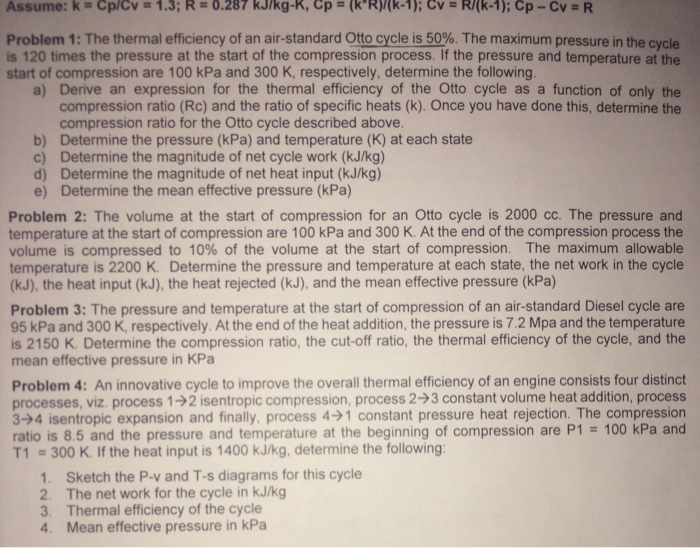Answered step by step
Verified Expert Solution
Question
1 Approved Answer
Assume: k = Cp/Cv = 1.3; R = 0.287 kJ/kg-K, Cp = (kR)/(k-1); = R/(k-1); Cp-Cv=R Problem 1: The thermal efficiency of an air-standard

Assume: k = Cp/Cv = 1.3; R = 0.287 kJ/kg-K, Cp = (k"R)/(k-1); = R/(k-1); Cp-Cv=R Problem 1: The thermal efficiency of an air-standard Otto cycle is 50%. The maximum pressure in the cycle is 120 times the pressure at the start of the compression process. If the pressure and temperature at the start of compression are 100 kPa and 300 K, respectively, determine the following. a) Derive an expression for the thermal efficiency of the Otto cycle as a function of only the compression ratio (Rc) and the ratio of specific heats (k). Once you have done this, determine the compression ratio for the Otto cycle described above. Determine the pressure (kPa) and temperature (K) at each state b) c) Determine the magnitude of net cycle work (kJ/kg) d) Determine the magnitude of net heat input (kJ/kg) e) Determine the mean effective pressure (kPa) Problem 2: The volume at the start of compression for an Otto cycle is 2000 cc. The pressure and temperature at the start of compression are 100 kPa and 300 K. At the end of the compression process the volume is compressed to 10% of the volume at the start of compression. The maximum allowable temperature is 2200 K. Determine the pressure and temperature at each state, the net work in the cycle (kJ), the heat input (kJ), the heat rejected (kJ), and the mean effective pressure (kPa) Problem 3: The pressure and temperature at the start of compression of an air-standard Diesel cycle are 95 kPa and 300 K, respectively. At the end of the heat addition, the pressure is 7.2 Mpa and the temperature is 2150 K. Determine the compression ratio, the cut-off ratio, the thermal efficiency of the cycle, and the mean effective pressure in KPa Problem 4: An innovative cycle to improve the overall thermal efficiency of an engine consists four distinct processes, viz. process 1-2 isentropic compression, process 2-3 constant volume heat addition, process 3-4 isentropic expansion and finally, process 4-1 constant pressure heat rejection. The compression ratio is 8.5 and the pressure and temperature at the beginning of compression are P1 = 100 kPa and T1 = 300 K. If the heat input is 1400 kJ/kg, determine the following: 1. Sketch the P-v and T-s diagrams for this cycle 2. The net work for the cycle in kJ/kg 3. Thermal efficiency of the cycle 4. Mean effective pressure in kPa
Step by Step Solution
★★★★★
3.40 Rating (169 Votes )
There are 3 Steps involved in it
Step: 1

Get Instant Access to Expert-Tailored Solutions
See step-by-step solutions with expert insights and AI powered tools for academic success
Step: 2

Step: 3

Ace Your Homework with AI
Get the answers you need in no time with our AI-driven, step-by-step assistance
Get Started


